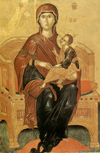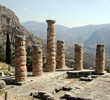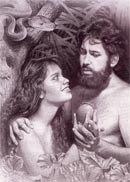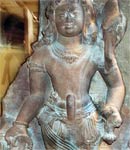" ... an immense multitude was convicted, not so much of the crime of firing the city, as of hatred against mankind."
– Tacitus, Annals, 15.44.
"Celsus says … converts [to Christianity] were deceived and accepted a doctrine harmful to the life of mankind."
– Origen, Contra Celsum 1.27.
Adoration of a sexless Mother Goddess
The Christians neutered female sexuality by manufacturing a passive goddess who moved seamlessly from virginity to motherhood without the nasty business of sex in between.
The joyful temples of the pagans, which had served the mother goddess for millennia, were an early target of the Church fathers.
The wrecking crews were monks not barbarians.
In a famous, if ludicrous, parable about "virgins and their lamps" even the godman seems quite comfortable with the idea that 10 women are about to marry one bridegroom.
At midnight, 5 of the women go off to buy forgotten lamp oil – and miss out on their nuptials with the lucky polygamist.
.
"And while they went to buy, the bridegroom came; and they that were ready went in with him to the marriage: and the door was shut."
– Matthew 25.10.Of course, the story is meant to convey a warning about "being ready for the kingdom."
But why on earth feature polygamy unless to give tacit endorsement?
Perhaps the authors of the tale were inspired by the adventures of King David's son Absolom who "went in unto" ten of his father's concubines "in the sight of all Israel." – 2 Samuel 16.22.
A Stoic view of desire
"To be pulled by the strings of desire belongs both to wild beasts and to men who have made themselves into women."
– Marcus Aurelius, Meditations, 3.16.
For Roman Stoics like Marcus, sexual abstinence preserved the "vital heat" of manliness.Christian ethics (as well as the utterances of their godman!) had less to do with any "apostolic tradition" than with the common Stoic and Platonic inheritance of the age.
"Nero fastened the guilt and inflicted the most exquisite tortures on a class hated for their abominations, called Christians by the populace …
Accordingly, an arrest was first made of all who pleaded guilty; then, upon their information, an immense multitude was convicted, not so much of the crime of firing the city, as of hatred against mankind."
– Tacitus, Annals, 15.44.
Jesus Christ – descended from a whore!
According to the yarn in Joshua 2, the Canaanite prostitute Rahab saved her own skin by betraying the city of Jericho. She hid Joshua's spies, lied about it, and then aided their escape.
Rahab's reward was to be given to a Jew and to bear the line of David – which, of course, would lead to JC himself!
"And Salmon begat Booz of Rahab; and Booz begat Obed of Ruth; and Obed begat Jesse; And Jesse begat David the king ...
And Jacob begat Joseph the husband of Mary, of whom was born Jesus who is called Christ."
– Matthew, 1.5,16.
Christian sex attitudes?
"Like an angel"
"He who does not marry becomes like the angels in heaven."
– St Ambrose, Treatise on Chastity and Celibacy
Christian sex attitudes?
"Morbid and unnatural"

Bertrand Russell, philosopher and Nobel prize winner:
"The worst feature of the Christian religion is its attitude toward sex - an attitude so morbid and so unnatural that it can be understood only when taken in relation to the sickness of the civilized world at the time the Roman Empire was decaying."
- Has Religion Made Useful Contributions to Civilization?, 1930
Nudity - Natural or Shame?
A relaxed attitude towards nudity can teach children that the body is not a source of shame but rather is a source of beauty.
The point was not lost in the ancient world but the great monotheisms have cursed humanity with alienation from the body.
A nation of prudes
Shock! Horror! Firm-breasted J. Jackson's right mammary outrages a Christian nation.
US Congress devotes 33 days to discussing Broadcast Indecency.
|
From Judaism, the enthusiasts of Christ derived the notion that the body was a source of shame and that women were an inferior breed. They agreed with the rabbis that the role of the priest was to license permissible sex and police the most intimate of human behaviour. But the early Christians were also influenced by Hellenic ideas that the passions were inherently suspect, that sex was harmful to the soul, and that abstinence was the path of spiritual purity. The circumspection, disdain and outright condemnation of human sexuality in the dogmas of the church gave rise, for two millennia, not only to the most monumental hypocrisy but to all manner of sexual-emotional disorders.
Why doesn't Jesus like sex?
Judaism was misogynistic, prescriptive and racist. It encumbered sexual behaviour with ritual and "Law". But in Judaism the misogyny which marginalised women was overshadowed by man's relationship with the Almighty. Clearly, under the Law, "God" approved of both gender differences and sexual intercourse.
Yet Judaism distrusted and disparaged women, even as it used them to increase the stock of Jews. It was but a small step for fanatical radicals within Judaism to adopt celibacy as a surety of the righteous "purity" so precious to their heart. One such group were the Essenes, many (though by no means all) of whom lived in male-only communities. For them, women stirred up lust, jealousy and pitted men against each other.
The curse of women – the female "temptress"
St Paul, or whoever wrote the epistles in his name, confessed to the torments of "concupiscence":
The Gnostic Challenge – The Polluted Spirit
But by the Augustan age the Romano-Hellenic world had drawn into itself the diverse traditions of Egypt, Persia and India, and this polyglot culture included Zoroastrianism, Mithraism and the notion of a cosmic struggle of "good and evil". The earliest Hellenised Christians sought to combine Jewish fables with a universal dualism, and had particular difficulty with the blood-thirsty god of Jewish scripture. This violent, judgemental being had to be a lesser god – the demiurge (from Greek 'demiurgos', 'creator'). Though acknowledged to be the maker of the world and of the flawed human body, this god had to be subordinate to a higher, loving god of pure spirit. And this supreme god was female.
Such speculations inevitably meant that gnosticism could not subscribe to the notion that God, the sublime spirit, would ever incarnate (or in some shades of opinion, reincarnate) as "flesh" or take human form. Nor could God suffer any kind of death. In the gnostic belief system (and in "gnostic Paul", Galatians 3.28), when the spirit ascends to union with the Lord, “neither male nor female” will exist. There will be no sex in heaven. In this, the material world, marriage and procreation were the work of dark powers and principalities, "base matter" begetting more "base matter". The 2nd century followers of the gnostic Marcion, who wrote pseudonymously in the name of "Paul", made clear that, if possible, the godly should practice self-restraint:
Ironically, while gnosticism would be driven from the world stage by its Catholic enemies, it was gnosticism's negative view of the body which would underpin many of Catholicism's worst traits: a bleak asceticism, starvation fasting, flagellation, and the whole paraphernalia of mortification of the flesh. The early Church Fathers, including the authors of Paul's epistles, glorified the asceticism that had been a discipline of the gnostics. Martyrdom, the ultimate mortification of the body, became the epitome of spirituality, a fast-track to salvation.
Virgin purity: closer to God
To meet the insult and underpin their hero's claim to divinity, the early Christians copied a motif common enough among the pagans. They gave JC a "virgin birth" (Matthew 1.18; Luke 1.27), a miraculous nativity which "proved" his godliness and gave him a pedigree equal to that of any pagan deity. The new god thus entered the world without the mess and inconvenience of sex. In the process, the sacred feminine, formerly the active element in procreation, was reduced to that of a passive receptacle, a "mother of god" rather than a goddess in her own right, done to rather than doing. In time, as the sacred feminine was relentlessly subsumed into Catholicism, the virginity of the godman's mother would be extended through the birthing process (virginitas in partu) and on through the rest of her life (virginitas post partum). This created a theological conundrum because the sacred history had already given the godman four brothers and two sisters (Mark 6.3; Matthew 13.55,56)! But extra-biblical fabrication (‘Protevangelium of James’) would come to the rescue, making JC's siblings into step-brothers and step-sisters. Later, Jerome would downgrade the inconvenient siblings further, into mere "cousins". At the same time Catholicism acquired a transcendent, sexless and meek "queen of heaven", forever at the hierarchy's beck and call.
Lethal brew – Catholic Orthodoxy
Organised into cells and a command structure of bishops, priests and deacons, the Catholics outwitted and outmanoeuvred the heterogeneous and democratic communities of the gnostics. The gnostic leaders had charisma and intellect but their doctrines were complex and esoteric. Catholicism's "theology" was simple, reducible to a few chantable creeds, and its ceremonies were public pageants, open to all who had merely to "accept Christ" and "believe". The gnostics were contemptuous of such easy and meaningless salvation. For them, neophytes had to train for months, even years, before entering the "inner mysteries"; they had to live as Christians and not merely profess the faith. In contrast, the Catholics adopted and adapted whatever was popular in the practices and traditions of the pagans in order to draw an indifferent population into the church. They forgave "sins" readily, including murder and sexual indiscretions. As disputes in north Africa were to show, even sacraments performed by heretics were deemed acceptable, if the correct formula had been followed. The "open door" of Catholicism prevailed against the "elect circle" of gnosticism. Sex the enemy of holiness
The gnostics and Stoics had already declared "the passions" suspect. The apologist Justin, in the mid-years of the 2nd century, could boast that there were already old men "in Christ" who had maintained an "immaculate purity" their entire life (Apology I.2). Antipathy to the sex act became a cornerstone of the new religion. Church father Tertullian (160-220) feared that a man's soul was lost in the moment of ejaculation:
Part of the tragedy was that at a time when the empire of Rome desperately needed manpower, the Church fathers were encouraging chastity and continence, of men as well as women, as a path to "spirituality". A life devoted to God – that is, of service to the Church – demanded nothing less. The individual's glorious self-denial anticipated the coming kingdom of the Lord, a time of untainted spiritual purity. In the vain hope for the kingdom of virginity they sacrified civilization itself.
A shadow over marriage Another Church father, Clement of Alexandria (?153-215), drew up a code of rules for the brethren, how they were to walk, sit, speak, etc. Whilst he accepted the necessity of marriage – had not most disciples been married, after all? – Clement insisted that Christian decorum must prevail in the bedroom as well as in the public meeting place. A lustful romp was "vulgar and plebeian":
Indeed, many early Christians willingly adhered to a rigid asceticism which denied the value of other physical or "earthly" pleasures: adequate food and drink, comfortable shelter and clothing, the pleasures of a social existence. Attendance of the theatre and the circus were particularly abhorred.
Sources:
'Save' a friend e-mail this page Copyright © 2007
by Kenneth Humphreys.
|
|||||||||||||||||||||||||||||||||||||||||||||||||||||||||||













